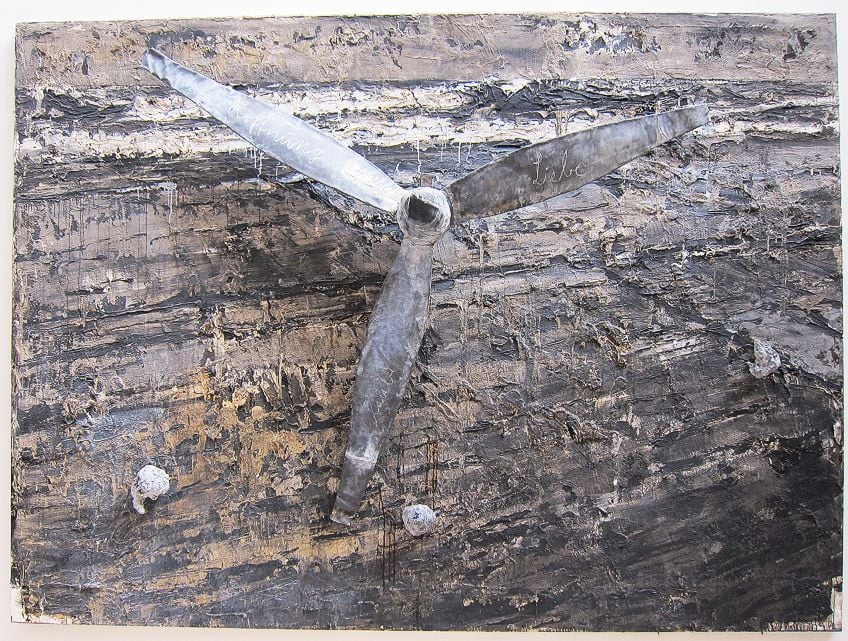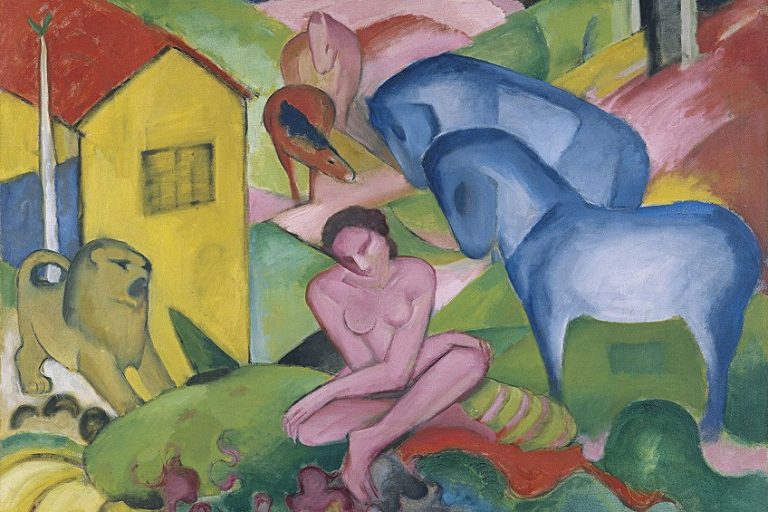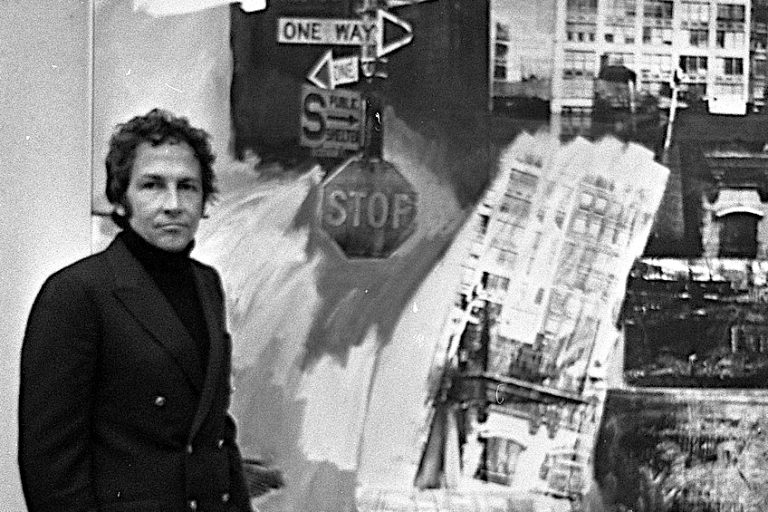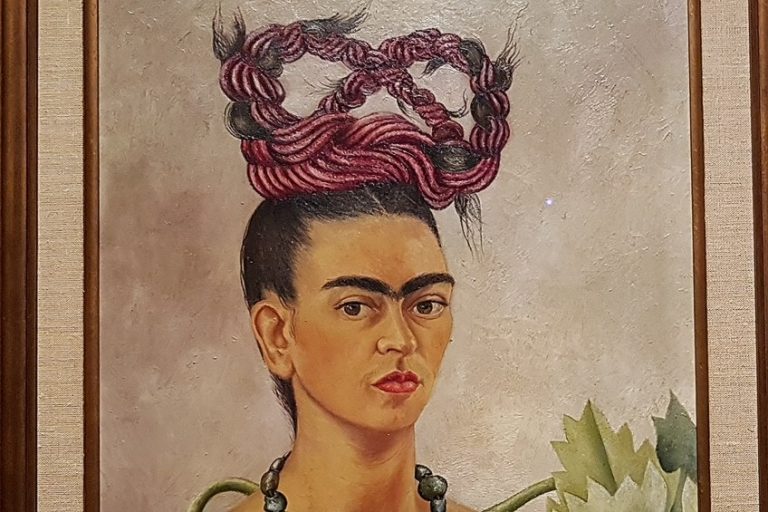Anselm Kiefer – Exploring the Life and Art of This German Artist
Anselm Kiefer’s artworks are massive and frequently aggressive. They were regarded as revolutionary at a period when the artistic medium of painting was thought to be all but obsolete. The German artist is well renowned for his artwork about his country’s history and mythology, specifically as it pertains to the Holocaust. Anselm Kiefer’s paintings use strong impasto and unusual elements like lead, shattered glass, hay, dried out flowers, and many of them evoke certain components of Germany’s past and as well as its tales.
The Life and Art of German Artist Anselm Kiefer
| Nationality | German |
| Date of Birth | 8 March 1945 |
| Date of Death | N/A |
| Place of Birth | Donaueschingen, Baden-Wurttemberg |
Kiefer is a classic historical artist in the sense that his work frequently focuses on topics relating to the national identity and history of Germany and its people, such as Wagnerian opera, Norse legend, and the Holocaust. The latter was an effort to push the Nazi era to the center of national debate, which frequently sparked outrage.
The imagery of Anselm Kiefer’s artwork is diverse, integrating figurative and symbolic themes like sigils, occult iconography, structural interiors, and environmental features to elicit a psychological and emotional response from the spectator.
Most of these draw clear parallels to parts of German history, such as the woodlands that remind legendary battles or the Grimm Brothers’ folk tales. Kiefer is attracted to a wide range of odd media because of their metaphorical power. Natural elements like straw, soil, and tree roots all allude to time as well as cycles of existence, mortality, and destruction. Lead has significance for the creator as both a material and a topic. It was the basic substance used in alchemy, and he believes it is the only substance heavy enough to withstand the weight of the past.
Childhood and Early Life
German artist Anselm Kiefer was born on the 8th of March, 1945, during the last months of World War II. Kiefer, the child of an art instructor, was captivated by painting and imagined himself as a painter. He was reared in a Catholic family close to the Rhine’s eastern bank in the black forest, a setting that would shape his growth as an artist and supply images and meaning for his works.
In 1951, his family relocated to Ottersdorf, and he entered Rastatt grammar school. Despite his early creative interests, he pursued Law and Romance language studies at the Albert-Universitat in Freiberg between 1965 and 1966.
Shortly after, he relinquished his ambition to become a lawyer in order to focus completely on visual art, enrolling in studies at the Staatliche Akademie der Bildenden Kunste in Karlsruhe with the prominent painter Peter Dreher.
Aged 24, he also journeyed widely around Europe at this time. Kiefer belonged to an era of Germans who felt the sorrow and remorse of the Holocaust but had no firsthand experience with it. According to the artist, the absence of discussion of WWII at school served as an artistic fountain of inspiration for him.
He started his creative career with the controversial picture series “Occupations” (1969), which sparked controversy due to its explicit reference to Nazi Germany.
Mature Work
Kiefer came to Düsseldorf in 1970 to study at the Staatliche Kunstakademie and encountered the painter Joseph Beuys, who had a lasting impact on him as a teacher and unofficial instructor. Beuys recognized enormous promise in Kiefer and encouraged him to try painting after being impressed by his use of sarcasm regarding Germany’s history. As a consequence, Kiefer shifted from photography to other mediums, producing his first huge landscape paintings in 1971.
Kiefer started to build his own distinctive visual style, concentrating on dramatic landscapes and interior spaces, leaning heavily on Beuys’ theoretical style and employment of symbolism. He continued to examine topics of German past, tradition, and folklore, representing the country’s agricultural meadows while dealing with the cultural traditions of Germany’s past, such as Caspar David Friedrich and composer Wilhelm Richard Wagner.
These pieces appear to be simple pastoral landscapes at first look, yet they are tinged with Germany’s macabre past, suggesting the bleak plains of mass grave sites and extermination camps. Beuys would have a long impact on Kiefer’s work, but he also contacted kindred Neo-Expressionist artist Georg Baselitz, who became his first sponsor and artistic partner during this time.

In 1974, Baselitz acquired many Kiefer paintings, allowing the painter to pursue his landmark early series regardless of their controversial subject matter. Kiefer went outside of Germany numerous times throughout the 1970s and 1980s, including excursions to the United States, Europe, and the Middle East. These events had a significant impact on his worldview and work, prompting a turn away from topics of German history and toward issues more widely connected to the functions of artwork and myths in societal and religious situations.
He included aspects of Jewish mysticism and Kabbalah beliefs into his works, influenced by the cultural revolutions in Israel especially. Motivated by a trip to Egypt, Kiefer stole the rich graphic language of religious devotion and hieroglyphic symbolism from the country’s extensive collection of ancient art and antiquities. While this time saw the employment of new themes, such as sigils, as well as a fixation with metaphysical and esoteric symbolism, it was also marked by Anselm Kiefer’s use of a variety of new materials.

For the first time in his work, the artist utilized straw in his 1981 series Margarete and Shulamite, which he favored for its palpable, flexible, and transitory features. While he had previously experimented with glass, organic materials such as straw, wildflowers, and ash would become staples in his works. Lead, which he had utilized in past projects, also became increasingly prominent during this era after he purchased the lead roof of a Cologne cathedral during its renovation in the 1980s.
Kiefer rose to international notoriety when Neo-Expressionism gained traction in the late 1970s and early 1980s, and he was selected to represent Germany at the Venice Biennale alongside Alfred Stieglitz in 1980.
This choice, made by the Director of the Stadelsche Kunstinstitut Klaus Gallwitz, confirmed Neo-Expressionism as a movement and required the country to confront German history from an international perspective. The show also catapulted Kiefer’s reputation into the worldwide art scene, resulting in enormous acclaim.
Later Life
Kiefer divorced his first wife of around 20 years and their three children in 1992 and relocated from a tiny hamlet outside of Frankfurt to a huge facility in France, which had been a disused silk mill. Kiefer gradually converted the site into a Gesamtkunstwerk, complete with towers, tunnels, and structures.
Between 1995 and 2001, he ventured outside his usual subject matter, embarking on an abstract series focused on the universe and expanding his repertory of topics and mediums.
Simultaneously, he rekindled his long-held interest in sculpture and text, producing a captivating series centered on Velimir Khlebnikov, the Russian Futurist poet, and rediscovered the works of Paul Celan, whose texts appear throughout Kiefer’s career.
Legacy
While Kiefer gained popularity during the Neo-Expressionist style in the 1970s and 1980s, his works continue to connect with artists and viewers alike. His utilization of materials, inspired partially by Robert Rauschenberg’s assemblages and the oddness of Arte Povera, rekindled interest in the metaphoric use of common non-art elements in the painting.
This part of his technique renewed interest in three-dimensional, multi-layered canvases and prompted subsequent artists, including Dan Colen and Zhang Huan, to explore with materials more extensively.
Anselm Kiefer’s paintings are complex compositions with austere topics that have left an indelible mark on artists working in a variety of mediums, including artists Stephen Barclay, and Christopher Bramham. Anselm Kiefer’s artwork veers between abstractions and figuration, with a particularly poetic and emotional approach that abandons the harsh aesthetic of Conceptual art in lieu of a more evocative, impressionistic, and moral symbolic imagery.
Anselm Kiefer’s Artwork
Kiefer frequently utilizes books as subject matter to depict knowledge and culture, which stems from his fascination with mythology, history, and information. Similarly, he regularly integrates text into his works, such as fragments from poetry, books, and nationalist statements, as well as the names of significant personalities in scrawling type.
The German artist has created totemic landscape sceneries and funereal statues with rich materiality that indicates historical accretion.
Occupations (1969)
| Date Completed | 1969 |
| Medium | Photograph |
| Dimensions | 29 cm x 21 cm |
| Current Location | Private Collection |
Kiefer’s infamous first collection of work consisted of a set of photographic self-portraits that faced Nazi Germany’s past head-on. Kiefer had his portrait shot at numerous historically relevant locales in France, Switzerland, and Italy, encompassing state landmarks and ancient ruins, while dressed in his father’s army fatigues and posed in the Hitlergruss gesture. In this shot, the painter is approaching the water with his back to the observer, in a Romantic pose influenced by David Caspar Friedrich.
Anselm Kiefer’s artwork, like Friedrich’s painting “Wanderer Above the Sea of Fog” (1818), displays a man with his eyes pointed outward, commanding the environment before him while being swallowed by it.
Kiefer unites these two apparently dissimilar eras of German history by posing in a historically Romantic attitude and stretching his arm in the Nazi salute, implying that Germany’s love of nation has been an enduring element of their history since at least the early 19th century. The imperialist and patriotic views of the Romantic era, spurred by Napoleonic conquests, were used by Third Reich officials, culminating in the Holocaust horrors.
While this piece is aesthetically distinct from his subsequent work, it introduces topics that became fundamental to Kiefer’s studies of Germany’s heritage and national pain.
Occupations were Kiefer’s first solo show in Karlsruhe, Germany, in 1969. Though Kiefer’s instructor, Rainer Kuchenmeister, complimented the work, the show garnered poor feedback from Kiefer’s peers and the general German audience.
German Spiritual Heroes (1973)
| Date Completed | 1973 |
| Medium | Oil and Charcoal on Canvas |
| Dimensions | 300 cm x 435 cm |
| Current Location | Barbara and Eugene Schwartz |
This huge artwork, which was displayed in the German Pavilion at the 1980 Venice Biennale, sparked debate and elicited vastly divergent responses. The artwork portrays a vast, empty wooden building resembling medieval construction, with tapers blazing at regular intervals around the wall. The desolate expanse calls into doubt the existence of the German heroes referenced in the title, maybe hinting that national identity must be reconstructed from the ground up following the calamitous events of the Holocaust.
Some commentators misunderstood the paradox of the title, “German Spiritual Heroes”, and claimed the piece promoted a widespread infatuation with German heritage while ignoring the nation’s harshness. Others interpreted it as a contemplative look back at German culture and the country’s response to its recent times.
This internal pattern recurred throughout Ansel Kiefer’s artwork all through the 1970s, such as in his Attic Paintings series. These interiors, like Vincent van Gogh’s depictions of his bedroom, represent the artist’s and the nation’s mentality, imbuing the viewer with a specific emotional response.
The artwork evokes an uncomfortable impression in the viewer by the gloomy picture of the empty chamber, implying that something is wrong. Kiefer, like the Occupations series, intended to break the silence about the Holocaust to stimulate regeneration and expansion beyond it, hence the depiction here of an empty chamber ready to be filled with new heroes.
While Kiefer is regarded as one of the most prominent painters to address this forbidden issue, he was part of a larger milieu of postwar German intellectuals struggling to escape their country’s sad past. Kiefer’s propensity of blatantly borrowing Nazi ideas, beliefs, and slogans, on the other hand, proved divisive.
According to academic Andreas Huyssen, “Kiefer’s purposeful approach of unleashing Pandora’s box of fascist and patriotic iconography amounted to a type of original sin of the post-Auschwitz era” for German critics. As a result, his art was frequently misconstrued as promoting Nazi ideology rather than challenging them, eliciting repulsion and scorn from his viewers.
Varus (1976)
| Date Completed | 1976 |
| Medium | Oil and Acrylic on Burlap |
| Dimensions | 270 cm x 200 cm |
| Current Location | Centre Georges Pompidou, Paris |
Kiefer has claimed that “our narratives start in the woods,” thus it’s no surprise that woods appear frequently in his art. For the artist, the motif has a lot of resonance, especially as a depiction of German national identity dating back to the Teutonic period. Varus refers to a fight in the Teutoburg Forest in the year 9 BCE, in which Hermann Arminius, a fugitive from the Roman army, in collaboration with his indigenous Germanic peoples, wiped off the Romans under the direction of Varus, who died on his sword after witnessing his soldiers be killed.
Tacitus recorded the devastating loss in Annales, which was recovered in the 15th century and became a pillar of German identification as a people of greater simple virtue with an almost mythological tie to their territory, a people who beat those tainted by cosmopolitanism.
The names of some of the individuals participating in the conflict, notably Arminius and his wife Thusnelda, are inscribed on the canvas, together with other figures from the German past and culture, all of whom had a role in the establishment of German national character.
Friedrich Klopstock, Friedrich Holderlin, Johann Gottlieb Fichte, and Friedrich Schleiermacher’s names are inscribed on the limbs of the trees, as if creating a hall of fame. Otto von Bismarck, Martin Luther, Adolf Hitler, and others looked to Hermann as an example.
The scarlet in the snow reflects the bloodshed of Romans and others slaughtered in the woodland by Germans throughout the years. The trail through the forest comes to an end, signaling that a new and less violent route must be discovered.
The arrangement was inspired by Friedrich’s 1814 painting, The Chasseur in the Forest, in which a Napoleonic soldier goes into the German forests towards his destiny, once again celebrating a military success linked to the forest. Forests played an important role in several of the German fairytales documented by the Grimm Brothers, such as “Hansel and Gretel,” in conjunction with the Roman and Romantic periods.
Margarete (1981)
| Date Completed | 1981 |
| Medium | Oil and Straw on Canvas |
| Dimensions | 280 cm x 400 cm |
| Current Location | Saatchi Collection |
Margarete, one of Kiefer’s most well-known works, explores themes of memory, grief, and German history. The artwork is the culmination of a series inspired by Paul Celan the poet from Romania which depicts his imprisonment in a Nazi concentration camp. Celan builds a dramatic depiction of the Holocaust centered on two female characters, the German Margarete and the Jewish Shulamite, in which the fates of these two women are connected.
Kiefer translates Celan’s literary themes into the visual arts to inspire the audience to think about the horror of the Holocaust, continuing his fascination with poetry and his utilization of text across his works. Margarete is blonde in the poem, which is represented in the artwork by straw, which became a recurrent material for Kiefer, but was employed here for the first time.
Kiefer chose straw for its potential to be twisted and burnt, as well as its symbolic allusion to life rhythms, racial superiority, and the German appreciation of the land. Additionally, its malleable, sinuous, and delicate materiality refers to the precarious nature of life and its ultimate disintegration. Straw also alludes to Rumpelstiltskin, German mythology in which he turned straw into gold, just like an alchemist.
Recommended Reading
The German artist Kiefer is well known for his work depicting his country’s history and mythology, particularly as it relates to the Holocaust. Anselm Kiefer’s paintings include powerful impasto and strange ingredients such as lead, shattered glass, hay, and dried-out flowers, and many of them reflect aspects of Germany’s history as well as its stories. Here are some books you can check out if you would like to discover even more about Anselm Kiefer’s artwork and lifetime.
Anselm Kiefer: Heaven And Earth (2005) by Michael Auping
This book, a retrospective of Anselm Kiefer’s work, examines the artist’s whole career through the prism of one captivating topic. Anselm Kiefer has intertwined concepts of earth and heaven into his works, from his early sculptures to his most recent highly textured canvases, investigating the opposites of these notions while attempting to identify the transcendental quality that sets art firmly in between. Kiefer’s frequently contentious portrayals of Germany’s natural and social landscape include themes such as annihilation and resurrection, glory and disgrace, sin and salvation.
- A retrospective volume of Anselm Kiefer's work
- Addresses Kiefer's entire career through the lens of one theme
- Includes more than fifty reproductions and some rare early works
Anselm Kiefer (2015) by Daniel Arasse
Anselm Kiefer is one of the 20th century’s most influential and contentious painters. This book examines the substance of Kiefer’s work, beginning with his entry on the world art scene at the 1980 Venice Biennale when he ignited passionate controversy and debate about the “Germanness” of his installations. Since then, Kiefer has built a body of work that is protean, dramatic, gigantic, or personal, based on the moment, across a variety of mediums.
- Richly illustrated monograph of one of the most controversial artists
- 250 full-color and high-quality reproductions of Kiefer's artworks
- Includes 409 illustrations as well, 394 of which are in color
We hope you have enjoyed this article on Anselm Kiefer. Kiefer’s prodigious production has resulted in a corpus of work that includes painting, installations, sculptures, printing, and photography, all of which use symbolic, primordial elements like clay, lead, and ash. He is one of the most prominent European painters of his time, unapologetically examining historical issues and the impact of current European events. Kiefer frequently revisits certain subject matter or images, making work that connects with the concept of history as a constant cycle, touching on poetry, history, theology, and psychology.
Frequently Asked Questions
Who Is Anselm Kiefer?
Kiefer created his own intentionally indigenous collection of topics and symbols to investigate the thorny area of Germany’s past and national identity. Physical texture and visual intricacy in his artistic approach infuse subject matter and theme with rich, lively tactility. His topics vary from Teutonic mythology to alchemy and the essence of religion, and he explores them via a dizzying array of materials that incorporate all sorts of organic material.
What Is Anselm Kiefer Known For?
Kiefer is a German artist who has spent his career exploring his nation’s postwar image, past, and mythology. Kiefer’s oeuvre as a painter, sculpture, and installation artist is greatly influenced by materiality. His large-scale paintings have a distinctive texture due to his extensive use of colors blended with discovered organic debris.
Isabella studied at the University of Cape Town in South Africa and graduated with a Bachelor of Arts majoring in English Literature & Language and Psychology. Throughout her undergraduate years, she took Art History as an additional subject and absolutely loved it. Building on from her art history knowledge that began in high school, art has always been a particular area of fascination for her. From learning about artworks previously unknown to her, or sharpening her existing understanding of specific works, the ability to continue learning within this interesting sphere excites her greatly.
Her focal points of interest in art history encompass profiling specific artists and art movements, as it is these areas where she is able to really dig deep into the rich narrative of the art world. Additionally, she particularly enjoys exploring the different artistic styles of the 20th century, as well as the important impact that female artists have had on the development of art history.
Learn more about Isabella Meyer and the Art in Context Team.
Cite this Article
Isabella, Meyer, “Anselm Kiefer – Exploring the Life and Art of This German Artist.” Art in Context. March 18, 2022. URL: https://artincontext.org/anselm-kiefer/
Meyer, I. (2022, 18 March). Anselm Kiefer – Exploring the Life and Art of This German Artist. Art in Context. https://artincontext.org/anselm-kiefer/
Meyer, Isabella. “Anselm Kiefer – Exploring the Life and Art of This German Artist.” Art in Context, March 18, 2022. https://artincontext.org/anselm-kiefer/.













